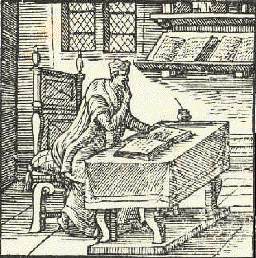The "University Wits"
The decade of the 1590s, just before Shakespeare started his career, saw a radical transformation in popular drama. A group of six feisty, well- educated men chose to write for the public stage, taking over native traditions. They brought new coherence in structure, and real wit and poetic power to the language.
As the title of this page suggests, they are known collectively as the "University Wits," though they did not always work as a group, and indeed wrangled with each other at times.
Click on the names below to read about each of the "university wits":
- John Lyly (1554-1606)*
- Thomas Lodge (c.1558-1625)*
- Christopher Marlowe (1564-1593)*
- Robert Greene (1560-1592)*
- Thomas Nashe (1567-1601)*
- George Peele
Footnotes
-
John Lyly (1554-1606)
Always on the fringe of the Court, Lyly never achieved the fame he sought. He is best known for his elaborate prose style, named after his moral prose romance, Euphues, the Anatomy of Wit, but he wrote several original comedies for the Court. His plays were performed by the child actors, the Children of the Chapel Royal, and the Paul's Boys.
-
Thomas Lodge (c.1558-1625)
Lodge's activities as dramatist were limited, but he collaborated with other writers of the period. The most popular of his joint efforts was a play he wrote with Robert Greene, A Looking Glass for London and England.
His prose romance Rosalynde--still eminently readable--was the source for Shakespeare's As You Like It.
-
Christopher Marlowe (1564-1593)
Born the same year as Shakespeare, Marlowe rose to deserved fame as a playwright well before Shakespeare had produced plays of real substance. Marlowe was rightly characterised by Ben Jonson as the creator of the "mighty line"--blank verse of great rhetorical power.
He was killed in a tavern brawl at the young age of 29.
-
Robert Greene (1560-1592)
Robert Greene, six years older than Shakespeare, has the melancholy distinction of being best remembered as the first negative critic of Shakespeare.
He was a perfectly competent, even original dramatist in his own right, wrote prose romances in the style of Lyly, and wrote a number of pamphlets on the subject of the London underworld of his time.
After a life of some dissolution, he died in 1592, just after writing A Groats-worth of Witte, Bought with a Million of Repentance, the pamphlet in which he attacked Shakespeare.
Ironically, one of his romances, Pandosto, was the source of Shakespeare's play The Winter's Tale.
Faustus' cousin?
His best, and best-known, play is Friar Bacon and Friar Bungay, written at about the same time as Marlowe's more famous Doctor Faustus, and dealing with the same subject of magic and the occult.
The title-page of the play preserves an illustration that gives some clues on early techniques of staging.
-
Thomas Nashe (1567-1601)
As a dramatist, Nashe is remembered for one odd satirical pastoral-cum-masque, Summer's Last Will and Testament, written for performance by child actors and designed to be acted in the Great Hall of a nobleman's house.
Nashe also wrote one scandalous play that has disappeared: The Isle of Dogs, written in collaboration with the young Ben Jonson, ended up with Jonson in jail for "seditious and slanderous" language. Nashe's love of political satire, very much in evidence in his pamphlets, seems to have gone too far in this case.
Nashe's best work is his prose narrative, The Unfortunate Traveller, a tale of the adventures of a young page in the time of Henry VIII.
